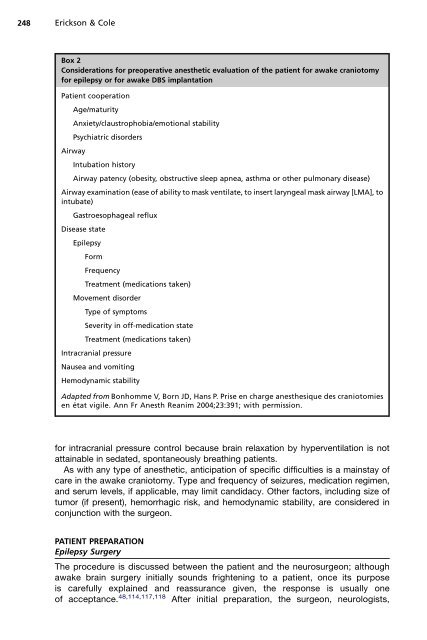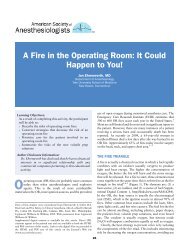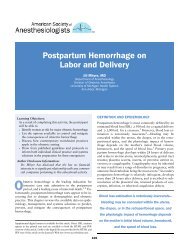Anesthetic Considerations for Awake Craniotomy for Epilepsy ... - Vtr
Anesthetic Considerations for Awake Craniotomy for Epilepsy ... - Vtr
Anesthetic Considerations for Awake Craniotomy for Epilepsy ... - Vtr
Create successful ePaper yourself
Turn your PDF publications into a flip-book with our unique Google optimized e-Paper software.
248<br />
Erickson & Cole<br />
Box 2<br />
<strong>Considerations</strong> <strong>for</strong> preoperative anesthetic evaluation of the patient <strong>for</strong> awake craniotomy<br />
<strong>for</strong> epilepsy or <strong>for</strong> awake DBS implantation<br />
Patient cooperation<br />
Age/maturity<br />
Anxiety/claustrophobia/emotional stability<br />
Psychiatric disorders<br />
Airway<br />
Intubation history<br />
Airway patency (obesity, obstructive sleep apnea, asthma or other pulmonary disease)<br />
Airway examination (ease of ability to mask ventilate, to insert laryngeal mask airway [LMA], to<br />
intubate)<br />
Gastroesophageal reflux<br />
Disease state<br />
<strong>Epilepsy</strong><br />
Form<br />
Frequency<br />
Treatment (medications taken)<br />
Movement disorder<br />
Type of symptoms<br />
Severity in off-medication state<br />
Treatment (medications taken)<br />
Intracranial pressure<br />
Nausea and vomiting<br />
Hemodynamic stability<br />
Adapted from Bonhomme V, Born JD, Hans P. Prise en charge anesthesique des craniotomies<br />
en état vigile. Ann Fr Anesth Reanim 2004;23:391; with permission.<br />
<strong>for</strong> intracranial pressure control because brain relaxation by hyperventilation is not<br />
attainable in sedated, spontaneously breathing patients.<br />
As with any type of anesthetic, anticipation of specific difficulties is a mainstay of<br />
care in the awake craniotomy. Type and frequency of seizures, medication regimen,<br />
and serum levels, if applicable, may limit candidacy. Other factors, including size of<br />
tumor (if present), hemorrhagic risk, and hemodynamic stability, are considered in<br />
conjunction with the surgeon.<br />
PATIENT PREPARATION<br />
<strong>Epilepsy</strong> Surgery<br />
The procedure is discussed between the patient and the neurosurgeon; although<br />
awake brain surgery initially sounds frightening to a patient, once its purpose<br />
is carefully explained and reassurance given, the response is usually one<br />
of acceptance. 48,114,117,118 After initial preparation, the surgeon, neurologists,




